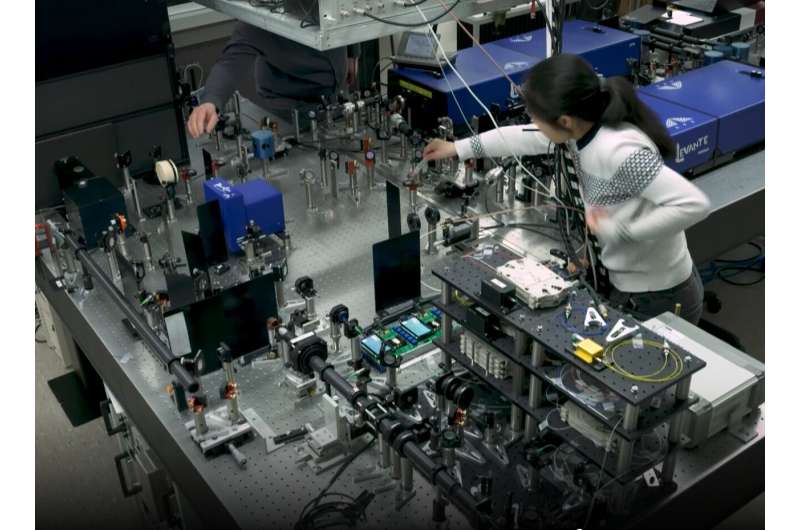The fibre-based microscope – the setup pictured here is in Bielefeld. Future versions of the device are intended to be made small enough to be portable. Credit: Bielefeld University/J. Kopp
When investigating how tumors grow, or how pharmaceuticals affect different types of cells, researchers have to understand how molecules within a cell react—and interact. This is possible with modern laser microscopy. Until now, however, molecules in cell specimens had to be labelled with fluorescent substances in order to make them visible, and this can distort the very behavior of the molecules. Research groups from Bielefeld University and the University of Hong Kong have developed a laser microscope that works without having to label the molecules. For this, the researchers innovated a unique compact fibre laser instead of the solid-state lasers that had previously been used. The new microscope generates far less noise when in use than customary designs, making it suitable for use in operating rooms. The researchers presented their innovative technology in the journal Light: Science and Applications, which is published by Springer Nature.
"Label-free microscopic imaging is currently a hot topic in biomedical research," says Professor Dr. Thomas Huser, a biophysicist who leads the Biomolecular Photonics research group at Bielefeld University. His team worked together with Professor Dr. Kenneth K.Y. Wong's research group at the University of Hong Kong on the fibre laser microscope.
"Staining with fluorescent markers is generally unsuitable for in-vivo tissues," says Huser. "Label-free microscopy is needed, for instance, to investigate how various new types of cells develop from stem cells. It also allows for a tumor to be demarcated from normal tissue without staining. And we can ascertain how pharmaceutical compounds react with molecules in the muscle tissue cells of the heart and liver, as well as other cells."
In recent years, fibre lasers have been frequently evaluated for use in optical nanomicroscopes, in which light is transmitted through glass fibres rather than through a solid body of crystal or glass. "In microscopes, however, fiber lasers were previously inferior to solid state lasers because they were less powerful and very noisy," explains Huser. To obtain molecule-specific imaging with their microscope, the scientists use not one but two synchronized optical resonators (laser cavities). Out of these resonators, the laser beams converge on the sample being tested. Both lasers send their wavelengths in short picosecond pulses—one picosecond being one billionth of a second. "One challenge here was controlling the lasers so that the wavelengths hit the specimen through the lens at exactly the same time," says Thomas Huser.
As Dr. Cihang (Sherry) Kong, explains, a significant advantage of the new fibre-laser microscope is that it is easier to operate than a classic solid-state laser microscope. Dr. Kong is a colleague of Thomas Huser and one of the lead authors on this study. "It is less prone to error, and because the molecules do not first have to be labelled, the specimen does not take as long to prepare as compared with using other microscopes." The prototype of the microscope will now serve as the basis from which to build portable devices. "A compact microscope could then be used in the operating room, for example to mark tumor borders during an operation," says Cihang Kong.
To ensure that the fiber laser microscope can be easily reproduced, the researchers in both Bielefeld and Hong Kong are working on a prototype of the device. The cooperative research of the two groups was funded by the German Academic Exchange Service (DAAD) and the Hong Kong Research Grants Council (RGC), and will now continue as part of the EU project DeLIVER. "This has made it possible for us to share our knowledge with each other—we were able to conduct research at the lab in Hong Kong for several months, and colleagues from Hong Kong were able to come to Bielefeld and help us here," says Dr. Christian Pilger, who is a member of Huser's research group and is also a lead author of the study.
"The new technology offers advantages for many biomedical applications," says Kenneth Wong, who heads the research group in Hong Kong. "The early detection of tumors is only one specific example of this." For Kenneth Wong, the success of their research is the result of close cooperation over many years between Bielefeld University and the University of Hong Kong. "Research in biomedical and health technologies brings both of our universities together, especially when it comes to imaging techniques."
For Thomas Huser, there is a good possibility that the new microscope will be able to be used in clinical applications in the coming years. "Preliminary studies in cooperation with the Evangelisches Klinikum Bielefeld hospital are already underway to use the microscope to analyse liver tissue samples. Our project partners were amazed by what this microscope can do."
More information: Cihang Kong et al. High-contrast, fast chemical imaging by coherent Raman scattering using a self-synchronized two-colour fibre laser, Light: Science & Applications (2020). DOI: 10.1038/s41377-020-0259-2
Journal information: Light: Science & Applications
Provided by Bielefeld University






















